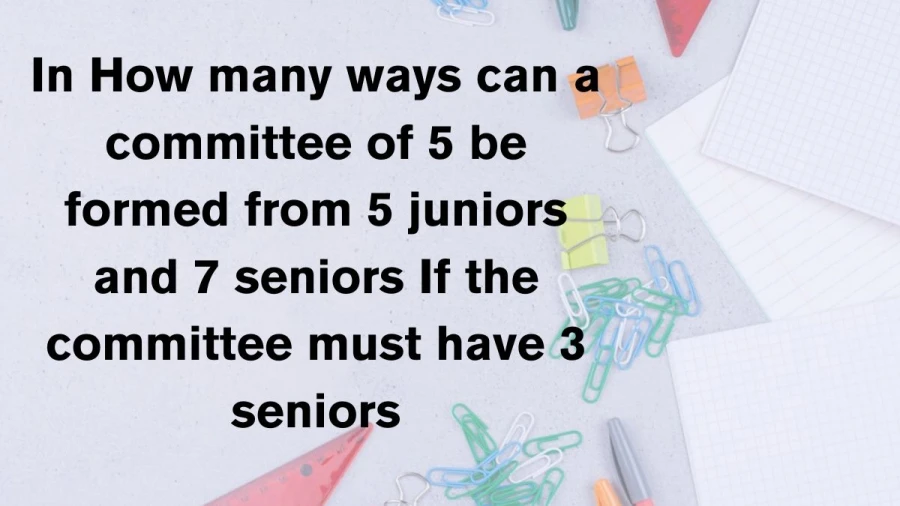If you happen to be viewing the article In How many ways can a committee of 5 be formed from 5 juniors and 7 seniors If the committee must have 3 seniors? ? on the website Math Hello Kitty, there are a couple of convenient ways for you to navigate through the content. You have the option to simply scroll down and leisurely read each section at your own pace. Alternatively, if you’re in a rush or looking for specific information, you can swiftly click on the table of contents provided. This will instantly direct you to the exact section that contains the information you need most urgently.
In How many ways can a committee of 5 be formed from 5 juniors and 7 seniors If the committee must have 3 seniors?
There are 350 ways to form a committee of 5 with 3 seniors and 2 juniors.
To form a committee of 5 with 3 seniors and 2 juniors, we need to calculate the number of ways to choose 3 seniors out of 7 and 2 juniors out of 5, then multiply these combinations together.
Article continues below advertisement
The number of ways to choose 3 seniors out of 7 is calculated using the combination formula:
7 choose 3, which equals 7! / (3! * (7-3)!) = (7 * 6 * 5) / (3 * 2 * 1) = 35.
Similarly, the number of ways to choose 2 juniors out of 5 is:
5 choose 2, which equals 5! / (2! * (5-2)!) = (5 * 4) / (2 * 1) = 10.
To find the total number of ways to form the committee, we multiply these two combinations:
Total ways = (7 choose 3) * (5 choose 2) = 35 * 10 = 350.
So, there are 350 ways to form a committee of 5 with 3 seniors and 2 juniors.
Combinations and Permutations
Combinations and permutations are fundamental concepts in combinatorics, a branch of mathematics dealing with counting, arrangement, and combination of objects. Here’s a brief explanation of each:
Article continues below advertisement
Article continues below advertisement
Permutations: Permutations refer to the arrangements of objects where the order matters. For example, consider the word “ABC.” If you permute these letters, you could get “ABC,” “ACB,” “BAC,” “BCA,” “CAB,” and “CBA.” Each arrangement is considered a different permutation. The formula for permutations is given by:
P(n, r) = n! / (n – r)!
Where:
- n is the total number of objects.
- r is the number of objects taken at a time.
- n! denotes factorial of n, which is the product of all positive integers up to n.
Combinations: Combinations, on the other hand, are selections of items where the order doesn’t matter. Using the same example of the letters “ABC,” the combinations would be “ABC,” “ACB,” and “BCA,” but not “BAC,” “CAB,” or “CBA.” The formula for combinations is given by:
C(n, r) = n! / (r! * (n – r)!)
Where:
- n is the total number of objects.
- r is the number of objects taken at a time.
- n! denotes factorial of n, which is the product of all positive integers up to n.
In summary, permutations deal with the ordering of objects, while combinations focus on the selection of objects regardless of their order. Both concepts are crucial in various fields such as probability, statistics, and algorithm design.
Thank you so much for taking the time to read the article titled In How many ways can a committee of 5 be formed from 5 juniors and 7 seniors If the committee must have 3 seniors? written by Math Hello Kitty. Your support means a lot to us! We are glad that you found this article useful. If you have any feedback or thoughts, we would love to hear from you. Don’t forget to leave a comment and review on our website to help introduce it to others. Once again, we sincerely appreciate your support and thank you for being a valued reader!
Source: Math Hello Kitty
Categories: Math

